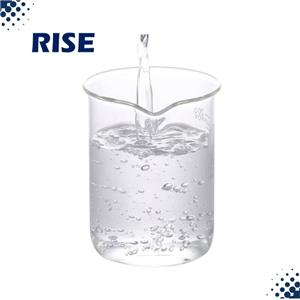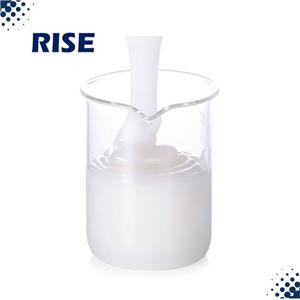Application of defoamer in concrete
The workability of fresh concrete has a great influence on the pumpability, construction performance, mechanical properties and durability of concrete after hardening, and the workability of fresh concrete depends to a large extent on the air content of concrete . In actual construction, the optimal air content range of concrete should be determined in the process of trial mix according to the different parts of the project and the function of concrete, and it should be effectively controlled to help ensure the construction quality of concrete.

Types of air bubbles in concrete
Before the concrete is vibrated, it contains a lot of air bubbles, mainly including air bubbles introduced during concrete mixing, transportation and blanking, air bubbles introduced by water reducing agent and tiny air bubbles introduced by air-entraining agent.
(1) Air bubbles introduced during concrete mixing, transportation and cutting. Such bubbles have large diameters, uneven distribution, and are extremely unstable. They are easily aggregated into bubbles with larger diameters, which are easy to burst, so they are called unstable bubbles. The unstable air bubbles introduced by mechanical stirring will adversely affect both the fluidity of concrete and the mechanical properties and durability of concrete after hardening.
(2) Air bubbles introduced by the water reducing agent. The water reducing agent can introduce a certain amount of air bubbles. Due to the same electrical repulsion, these air bubbles are located between the cement particles like ball bearings to disperse the cement particles, thereby increasing the sliding effect between the cement particles. However, these bubbles are uneven in size, irregular in shape and unstable. With the progress of transportation and vibrating, they tend to aggregate and merge into large bubbles, and eventually overflow to the concrete surface to form apparent bubbles, resulting in honeycomb pitting defects. .
(3) Air bubbles introduced by the air-entraining agent. The air-entraining agent can form many fine air bubbles with a size between (20-200) um and evenly distributed inside the concrete. The liquid film on the surface of such bubbles is relatively firm. From a thermodynamic point of view, that is, the electrokinetic potential of the liquid film is high, which can prevent the bubbles from coalescing, and the bubbles are relatively stable and not easy to burst. It is essentially different from the air bubbles introduced by the water reducing agent, which is beneficial to the impermeability and other durability of concrete.
Defoamers help to remove large air bubbles in concrete. On the one hand, adding construction concrete Defoamers can eliminate air bubbles between concrete and formwork to a certain extent, effectively prevent or eliminate the generation of honeycomb and pitted surface on concrete surface, and make the surface of concrete have high flatness and gloss. On the other hand, the concrete defoamer can eliminate a large number of air bubbles in the concrete, reduce the air content and internal porosity of the concrete, and improve the mechanical properties and durability of the concrete. The defoamer for concrete mainly eliminates the bubbles introduced by the water reducer. Therefore, the defoamer for concrete admixtures is often compounded in the polycarboxylate water reducer to solve the problem of large air entrainment of the polycarboxylate water reducer.
Compounding of defoamer and polycarboxylate superplasticizer
Due to the high gas content, high surface activity and good foam retention of the polycarboxylate superplasticizer mother liquid, when it is directly used in concrete, it will cause adverse effects such as high gas content, more apparent bubbles and low strength in concrete. Add an appropriate amount of defoamer to eliminate large air bubbles in concrete. The basic performance test of the combination of defoamer and polycarboxylate water reducer generally includes the compatibility of defoamer and water reducer and the effect of defoamer on concrete performance.
(1) Compatibility of antifoam and water reducer
The difficulty in compounding the defoamer with the polycarboxylate superplasticizer is the compatibility with the superplasticizer. The compatibility of concrete admixture antifoam and water reducer can be evaluated by testing the dissolution state of defoamer in polycarboxylate water reducer. The solubility of defoamer in polycarboxylate water reducer is good and long If the time is not stratified, the compatibility is good, and it can be compounded with the water reducing agent; while the antifoaming agent with poor compatibility cannot be compounded with the water reducing agent, and can only be added to the concrete alone. The defoamer and polycarboxylate superplasticizer are added to the cement paste, and the initial fluidity and fluidity loss of the cement paste can also be used to evaluate the performance of the defoamer and the polycarboxylate superplasticizer. compatibility. The defoamer with good compatibility with the polycarboxylate superplasticizer should be a defoamer that has no obvious adverse effect on the initial fluidity of cement paste and the loss of fluidity over time.
(2) Influence of defoaming agent on concrete properties The influence of defoamer on concrete properties is manifested in two aspects:
The working properties of concrete and the mechanical properties after hardening. Generally, the influence of defoamer on concrete performance is evaluated by testing the slump and slump loss, air content and strength of concrete. The defoaming agent, which can greatly reduce the air content of concrete, has little influence on concrete slump and slump loss, and can obviously improve the strength of concrete, has good effect.
For more details, please contact us for consultation. You are welcome to come and learn about our Rise Chemical. The 20-year production process will never disappoint you.




